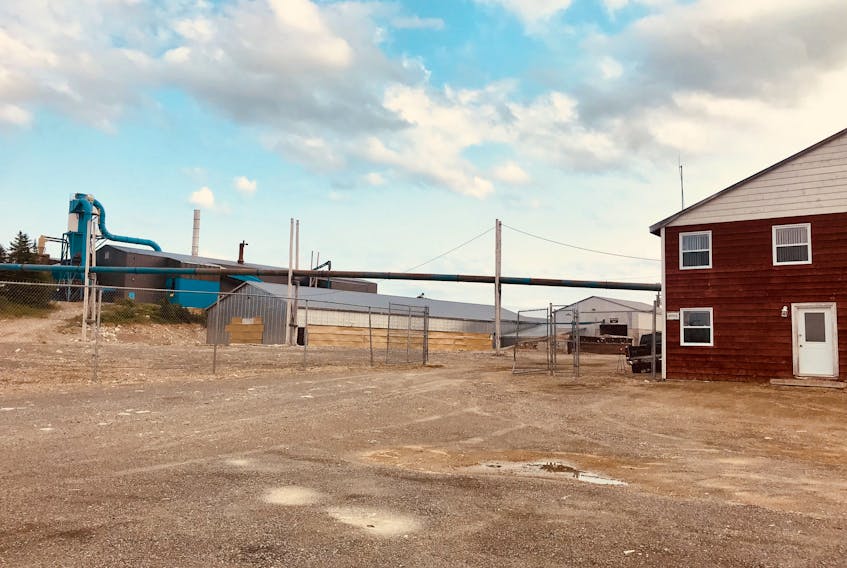RODDICKTON, N.L. — RODDICKTON-BIDE ARM, N.L.
Even though the government cannot afford to loan the company any more money, Fisheries and Land Resources Minister Gerry Byrne says the department has done what it can to help the Holson sawmill get back up and running in Roddickton-Bide Arm.
But the mayor of Roddickton-Bide Arm believes the permits Byrne’s department issued to Timberlands (a subsidiary of Active Energy Group - AEG), did little to ensure the Great Northern Peninsula will profit from its own forestry resource.
Mayor Sheila Fitzgerald is concerned the province has written away sawlogs to be used to produce wood pellets. And that logs may end up leaving the Great Northern Peninsula.
Sawlogs for pellets?
According to Byrne, about 50 per cent of a stand of timber, typically, can be used for sawlogs, although the percentage varies and can go higher and lower in different parts of the forest.
However, the two AEG permits, one for district 17 and one for district 18, stipulate that 25 per cent of the permit volume in each district will be utilized as sawlogs and made available to the local sawmill industry.
This means, hypothetically, there would be an additional 25 per cent of sawlog quality fibre that won’t be delivered to the mills. Twenty-five per cent equates to 16,625 cubic metres of wood in district 17 and 8,375 cubic metres in district 18.
Where does it go?
The permits do not dictate to the company what it is supposed to do with the remaining sawlogs.
Whatever happens with those logs is entirely at the discretion of the permit holders, Timberlands Newfoundland. The company can allow sawmillers to use it or direct it towards the pellet plant.
Fitzgerald told The Northern Pen she sees no reason why the company would not use at least some of it to produce pellets.
Furthermore, a direction note from the Department of Fisheries and Land resources, attained through an access to information request, indicates that the company has requested that “in lieu of no large scale sawmill in the area, Timberlands (Newfoundland) will use all available fibre in their process.”
In other words, if there is no large-scale sawmill operation in the area, Timberlands will be allowed to use all the sawlogs it cuts for pellet production at its plant in Hawke’s Bay.
The Department of Fisheries and Land Resources confirmed to The Northern Pen that, in such a scenario, it would “work with the company to explore other options, including more of the fibre for pellet production.”
But Fitzgerald does not believe any sawlogs should be used for pellet production. Instead, she says it should have been written into the permits that any sawlogs cut should be directed towards sawmills on the Great Northern Peninsula.
“Again, it feels like they’re giving the rights to our timber to somebody else to decide what they’re going to do with it,” she told The Northern Pen. “At the end of the day, they’re taking our fine wood, that millions have been spent to cultivate, to use it as soft wood. That’s unbelievable. That’s the same thing as having diamonds and selling them as rocks.”
Who are the “local” mills?
Meanwhile, questions remain around who will have first access to the sawlogs.
The permits for districts 17 and 18 state that the logs will be “made available to the local sawmill industry.”
But the term “local” is not defined.
The Department of Fisheries and Land Resources told The Northern Pen that “local” refers to the forest management districts for which the permits were issued – districts 17 and 18, which only includes the Great Northern Peninsula.
However, the statement continues, “if no operator is interested in purchasing sawlogs from the district where they were harvested, we would then look to the Forest Management District which is immediately adjacent to it on the Great Northern Peninsula.”
The department’s map of forestry districts shows district 16 as the nearest.
Fitzgerald doesn’t want to see logs leaving the Great Northern Peninsula.
“They know there’s no sawmill (as long as Holson isn’t operating) on the Northern Peninsula that can handle that volume of wood and they know they weren’t going to put any more money towards it — so, what were they doing?” she asked. “They were setting up the permits so that, in essence, we have a foreign investor (AEG) who has the rights to our timber and will make and reserve the right to make decisions around where all of that timber goes.
“Instead, they could have said, ‘We will approve that based on the fact that local means on the Northern Peninsula.’”
Feeling left out
Fitzgerald adds that locals feel left out of the decision-making process and are frustrated that their main resource may be taken away.
“There’s no mutual agreement, it’s not an even distribution of power here. We’re being told what the conditions are,” she said. “The people here are going to respond to that. You can’t pressure us to take away our only resource.
“So, you’re going to see people protesting, you’re going to see people blocking trucks, because people are frustrated. They feel like they have nowhere to go, they like feel they have no say.”
Fitzgerald has contacted Byrne, as well as St. Barbe – L’Anse aux Meadows MHA Christopher Mitchelmore, requesting a public meeting. She says, as of Jan. 22, they have not responded with a date and time for a meeting.
Status of Holson sawmill
Fisheries and Land Resources Minister Gerry Byrne has informed The Northern Pen that government will not be loaning Holson Forest Products more money to get its sawmill in Roddickton-Bide Arm operational again.
Whether the mill gets back up and running is between Holson and Active Energy Group (AEG), the minister says.

Byrne blamed the sawmill’s shutdown on Holson’s inability to find a market for small diameter wood but also, in part, on the Progressive Conservative government’s decision not to make the full investment.
He says a $20 million project was proposed by Holson in the late 2000s.
But the company was only awarded $12 million from the Progressive Conservative government of the day. This left an $8 million shortfall.
Holson’s operations shut down in 2012.
Now, Byrne says the present government does not intend to loan Holson more money.
“There’s no evidence, with the amount of time that has passed and the equipment being in the state it’s in, and other things, that we can reasonably and confidently get the project up,” he explained. “And I don’t think there’s any appetite to begin with, to put more money into this operation.”
Furthermore, Byrne says the government has to be careful not to violate trade law with the United States.
According to Byrne, the United States views any subsidies in the lumber industry to be anti-competitive and has shown itself to be prepared to act on any anti-competitive behaviour in Canada by imposing tariffs on Canadian, including Newfoundland and Labrador, lumber products.
“It would be devastating to our Newfoundland and Labrador industry, including the Northern Peninsula industry,” he said.
Byrne revealed the previous government was considering an arrangement where AEG would take over all of Holson’s debt, along with their aging stock of equipment.
The government would forgive the debt of AEG if certain job milestones were reached.
But Byrne says the problem with that arrangement is that the debt forgiveness would be perceived as a grant by the United States Department of Commerce, again subjecting the operation to US tariffs.
According to Byrne, this left the province with only one method to help get the Holson sawmill back up and running.
The current government decided to include conditions in the forestry permit for AEG, who is cutting small diameter wood for its wood pellets thus providing a market for that product, to also supply large diameter sawlogs to a local company like Holson or Coates’ Lumber in Main Brook.
But for the Roddickton-Bide Arm Mayor Sheila Fitzgerald and many residents in that community, the permits don’t do enough to ensure all of the sawlogs are cut at Great Northern Peninsula mills.









